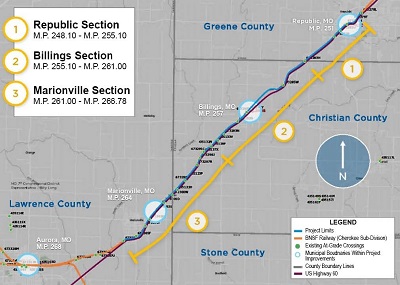Describe the roadway safety situation or state before the new practice was implemented. What was the safety issue, problem, or gap?
In Missouri, a rural corridor with 29 at-grade crossings experienced 62 incidents since 1975, including 14 fatalities and 19 injuries. Although the Missouri Department of Transportation (MoDOT) had previously suggested crossing closures as a means of increasing safety, many citizens who live in communities along the corridor use these crossings to access other sections of their towns and were initially resistant to crossing closures. MoDOT was struggling to reach consensus with local officials and communities on a solution.
What were the key challenges that needed to be addressed before the new practice could be implemented?
After unsuccessful attempts to reach a consensus, MoDOT realized it would need a new approach that would not only improve safety, but also fully address residents’ concerns.
Describe the new practice.

In January 2017, MoDOT commissioned a rail corridor safety study to:
- Evaluate all rail-highway crossings within the corridor.
- Provide streamlined solutions to increase safety.
- Deploy a public input process that would bring about community support for effective, collaborative consolidation and safety improvement recommendations.
To oversee the public input process, MoDOT hired a consultant to act as a neutral third party. The consultant’s approach was first to listen to the citizens’ perspectives, then present a series of alternative treatments MoDOT had identified for each crossing site. Each of the alternatives presented also included the results of a benefit-cost analysis. The consultant presented each option and let the communities vote on which to apply.
What technical and/or institutional changes resulted from the new practice?
As a result of this success, the MoDOT Rail Section is considering using this approach at another location along a similar length of railroad to engage the small rural communities along the corridor in building a consensus for safety improvements.
What benefits were realized as a result of the practice?
As a result of gaining public approval to proceed with safety treatments, once complete, the five proposed closures along with the many upgrades and site improvements throughout the corridor will allow for 23 fewer crashes, with 1.41 fewer fatal crashes, 7 fewer injury crashes, and 15 fewer non-injury crashes over a 25-year period as compared with the baseline estimates.
Contact
Chris S. Brownell
Missouri DOT
Sidney.Brownell@modot.mo.gov
